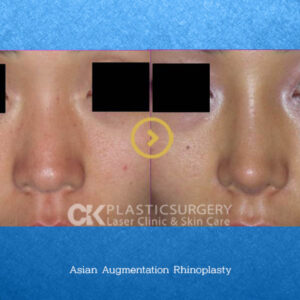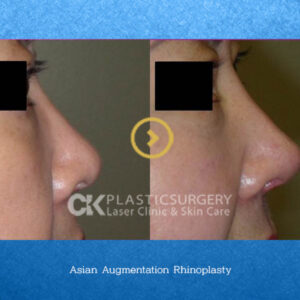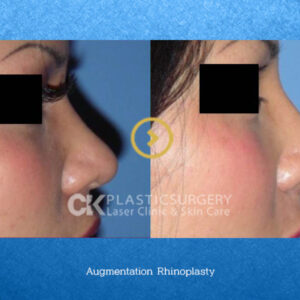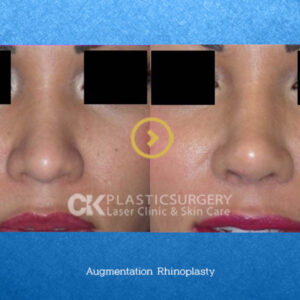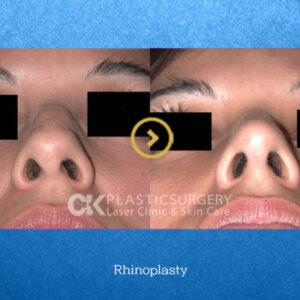
Kinds of Rhinoplasty
Rhinoplasty (also known as a Nose Job) is a popular cosmetic procedure that involves restructuring the nose to improve its appearance. Rhinoplasty may also be used to improve airflow for patients with a deviated septum or other issues that may restrict proper breathing. Due to the nose being the central focal point of the face, altering the shape of the nose can greatly improve overall facial balance and harmony.

Surgery Method:
Rhinoplasty may be performed using either an open or closed technique, the appropriate technique will depend on your individual needs and concerns. The procedure is typically performed under general anesthesia. And in some cases, it may be performed using a local injection or with intravenous (twilight) sedation. Most incisions are made inside the nose to promote faster recovery with a low chance of visible scarring (Closed Rhinoplasty), although, for patients needing more complex revisions, the Open Rhinoplasty method may be used.
Arrow & Upturned Nose

When the tip of the nose is downturned or drooping, this is often referred to as an arrow nose type. This causes the face to look older, or not as fresh and youthful. To remedy this an incision is made inside the nose to partially remove cartilage within the tip of the nose, then either an implant or the patient’s own autologous cartilage is used to firmly support the nose tip, preventing the recurrence of a drooping nose.
Subsequently, an upturned nose is one with a tip that’s angled upwards, the angle of the nose may vary from being slightly upturned to an overly-exaggerated angle that causes the nose to appear shorter while making the nostrils overly prominent. Upturned noses may be caused by previous Rhinoplasty operations, where an excessive amount of cartilage has been removed from the nose tip or septum, causing the tip to turn upward. Correction of an upturned nose can be performed using both open and closed surgical techniques. Both techniques generally involve placing grafts at the end of the septum and tip to help support and lengthen the nose. The grafts are created from the patient’s own cartilage taken from the ribs and/or ears.
Alar Reduction

Alar Reduction targets the base of the nose, or the bottom portion in which the nostrils lie, and aims to reduce broad nasal flaring or prominent nostrils. The procedure is quite simple, and therefore usually leaves minimal scarring. Alar Reduction involves removing a small portion of the skin closest to the inner portion of the nose to ensure the scar will be mostly invisible. After this skin is removed the nose is sutured together to form a more refined and harmonic nose.
Tip Plasty

Tiplasty is a surgical procedure that is specifically aimed at changing nasal tip cosmesis and is especially helpful for individuals who feel the tip of their nose appears too bulbous or round. Tiplasty is highly dependent on each individual patient’s needs and concerns but generally involves reshaping the existing cartilage in the patient’s nose.

Hump Reduction

Hump Reduction (Dorsal Hump Reduction) is a very common reason for patients to pursue a Rhinoplasty procedure. Dorsal humps are cartilage and bone irregularities on the nose. These irregularities can cause a bump or “hump” on the bridge of an individual’s nose, rather than a straight slope from the bridge of the nose to the tip. Many patients express feeling self-conscious about their appearance or profile because of this. Hump reduction requires general anesthesia, after the patient is sedated the nose is then reshaped to provide a smooth, natural appearance.
Septoplasty

Septoplasty is a surgical procedure to correct a deviated septum. The septum is the wall of bone and cartilage that divides your nose into two separate nostrils. A deviated septum occurs when your septum is moved to one side of your nose, which may impede your airflow and cause difficulty breathing. To start, Dr. Kim makes a small incision on one side of your nose to access the septum. Next, the mucous membrane is lifted up, this is the protective covering of the septum. Then the deviated septum is moved into the correct position. Any additional unneeded pieces of bone or cartilage, are removed. Finally, the mucous membrane is repositioned and the incision is closed.
Osteotomy

Osteotomy is the procedure designed to help narrow a wide nasal bridge and/or to straighten a crooked bridge. This generally involves cutting the bones that comprise the upper one-third of the nasal bridge, then repositioning the bones closer together to form a narrower, more aesthetically pleasing bridge.
Asian Rhinoplasty

Rhinoplasty for patients of Asian ethnicity requires a unique approach, given that the nasal bridge is typically less prominent and the tip of the nose is broader and less defined. The goal of Asian Rhinoplasty is to achieve a natural balance between improving and enhancing the shape of the nose while also maintaining the patient’s ethnic identity. This may involve the use of an implant to create a more prominent bridge, narrowing the width of the nostrils (Alar Reduction) or reducing a bulbous nose tip (Tiplasty). Asian noses are often characterized by thick skin, a low bridge height, and a bulbous, or rounded tip, which may give an unwanted flat or wide appearance. To enhance the prominence of the nose an implant is inserted to provide the additional support needed. The implant may be comprised of either a synthetic material such as Silicone or Gore-Tex (Alloplastic) or the patient’s won tissue (autologous) which is taken from the ear or rib cartilage. The use of synthetic materials offers some advantages in that they are readily available in unlimited supply, they reduce operating room time, and they provide good aesthetic results given proper fit. However, there may be risks involved including infection, migration of the implant over time, and extrusion of the implant through the eroding skin. Because of these risks it’s imperative to properly diagnose the patient’s skin elasticity, nose shape and expectations during the consultation phase. As a perfectionist, Dr. Kim thoroughly examines each patient to create an individualized, tailored plan to ensure excellent long-term results. This includes creating a custom mold of the patient’s nose, which enables Dr. Kim to shape the implant to perfection prior to surgery. Because of this added step, there is little worry of unwanted long-term effects, which may occur when the implant is quickly shaped and fitted in the operating room after swelling has already begun. While this method may provide short-term aesthetic relief, it can potentially alter the final result after swelling subsides causing unwanted effects. The goal is to minimize complications while providing aesthetically natural, realistic surgical results.



















